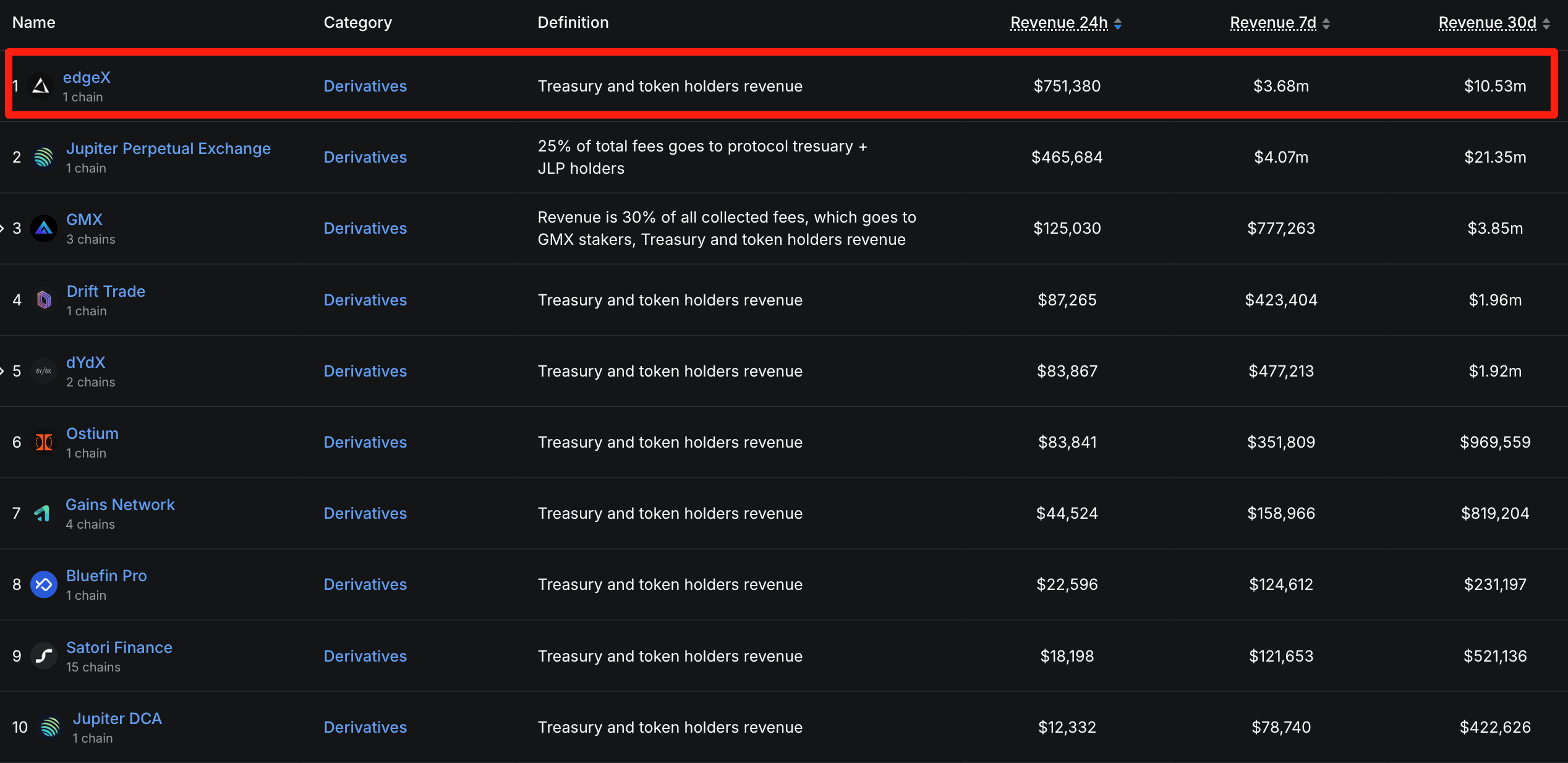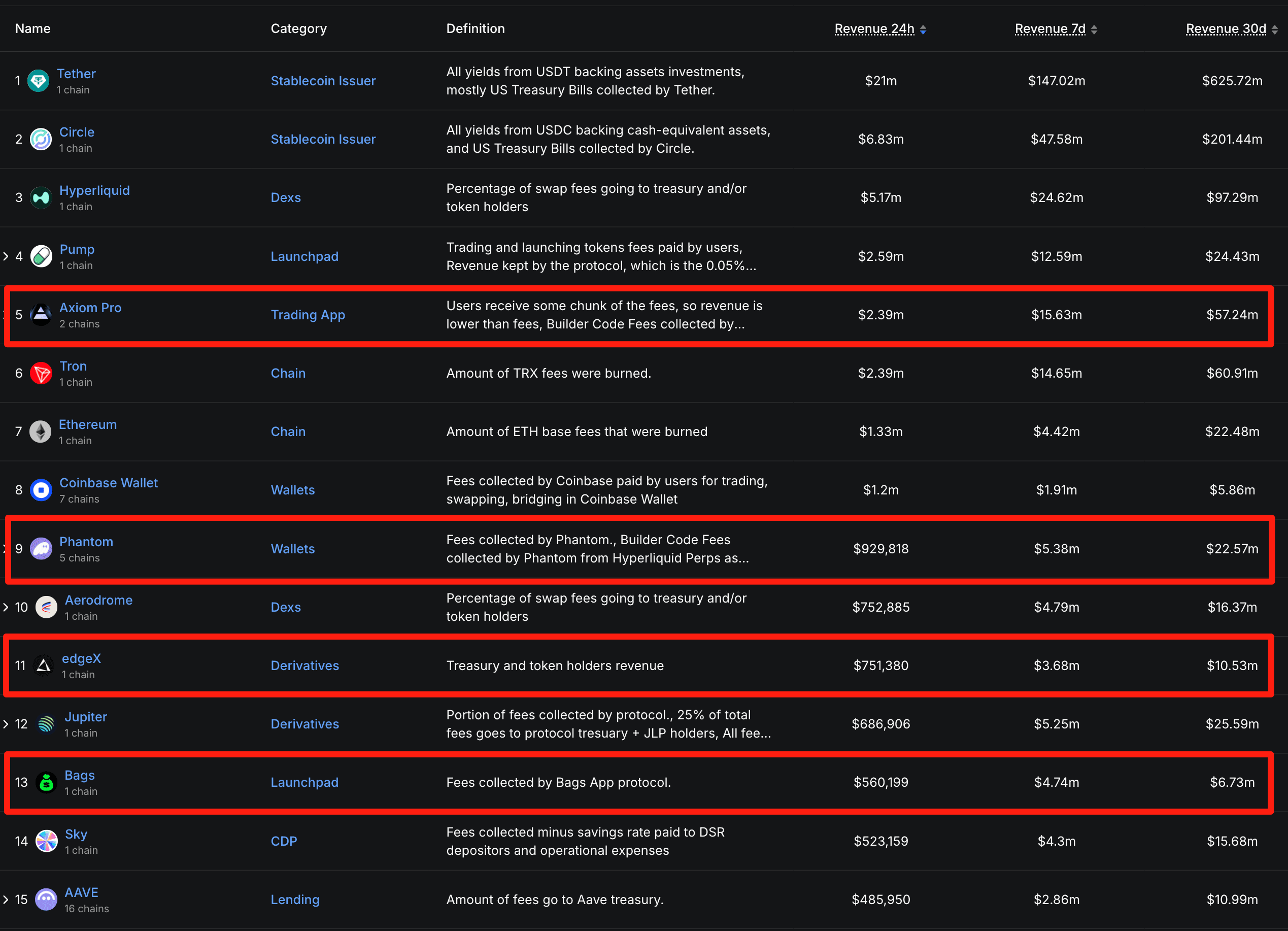Most people know that the most profitable business in the crypto world is contracts.
But can you imagine, a low-key dark horse Perp DEX that has only been operating for a year, surpassing Ethereum, Base, and other leading public chains in 24-hour revenue? When extended to 7 days, it tramples over Uniswap, Jupiter, AAVE, Lido, and many other DeFi veterans. It is one of the few projects in the top 15 daily revenue list that has not issued a token, and it also has the best liquidity depth for buying BTC and ETH within a 0.01% price difference range.
This new revenue curve 'monster' is called edgeX.
Why is the revenue curve so fierce?
Unlike the Hyperliquid we know, edgeX is a ZK-architecture perp DEX. The team background is incubated by Amber, with core members from a group that has deep experience in high-frequency trading from firms like Goldman Sachs and Jump Trading. In terms of product form, edgeX is more like an 'on-chain financial full-stack base': in addition to the perp DEX, there are also two other product lines, eStrategy (vault) and edgeX Chain.
As mentioned at the beginning of the article, the quality of the product is directly reflected in the income. Therefore, comparing revenue among perp DEXs can more directly show edgeX's ferocity.
As a perp DEX that has only been operating for a year, in the past 30 days, edgeX's fee income was $10.53 million, far exceeding the $3.85 million of veteran GMX and $1.92 million of dYdX. This means that edgeX's income is almost more than twice that of GMX and over five times that of dYdX.

Data Source: DefiLlama
So, how did edgeX break into the top tier of perp DEXs through its revenue curve? The answer may lie in trading depth and fees, the two metrics that traders care most about and find most intuitive.
In terms of liquidity depth, edgeX currently ranks second among all Perp DEXs. Taking the most core BTC/USDT as an example, within a 0.01% price difference range, edgeX's order book can support up to $6 million in BTC order volume, surpassing hyperliquid ($5 million), Aster ($4 million), and Lighter ($1 million). Although the overall depth is still slightly inferior to hyperliquid, in the majority of cryptocurrencies, edgeX is the second best in depth after hyperliquid. For more extended discussions on this point, refer to the latest article by edgeX's research lead, Dan (Understanding DEX Liquidity: A Comparative Look at Trading Efficiency), which delves deeper into the topic.
Additionally, edgeX offers the industry highly competitive rates for both Makers and Takers: Maker only 0.015%, Taker 0.038%, significantly lower than Hyperliquid's 0.045%. Moreover, users can unlock VIP1 level by registering through ambassador referral links, and Taker rates can be further reduced to 0.036%. Becoming an ambassador also allows for a maximum 35% fee rebate—saving on trading costs while continually accumulating airdrop points.
With such advantages in trading depth and fees, edgeX's moat has naturally formed, driving the growth of its revenue curve. Even though it has not issued a token yet, it proves that edgeX has the capability for continuous 'token buybacks' and generating funds for ecological construction.
Even more intriguing is when looking at the overall income leaderboard: among the top 15 protocols (excluding the issuers of stablecoins USDT and USDC), there are only four that have not issued tokens but are still in the top ranks, and edgeX is one of them.

Data Source: DefiLlama
Many friends in the Chinese community may not have heard of this dark horse's name because this perp DEX rarely engages in so-called narrative packaging, and its community audience is more concentrated in South Korea and North America.
In other words, this is an obvious high income, low valuation, and still in the token blank period of a rare Alpha.
Currently, edgeX uses edgeX Points as a contribution metric, distributing 2.4 million weekly. Methods to earn include trading volume, holdings, vault participation, and invitations, among others. Meanwhile, the edgeX Messenger Ambassador program is ongoing.
Trading volume can be manipulated, but profit income is hard to fake. Whether in traditional finance or the web3 industry, only the 'user willingness to pay' in terms of real money is the most direct validation of 'product sustainability'.
In less than a year, edgeX has made its cash flow rank among the top 15 in the industry, which is a highly certain growth curve, perhaps also a very strong alpha. What FDV will it launch with in the next phase, and what returns will it provide to early participants? We can also look forward to that.



